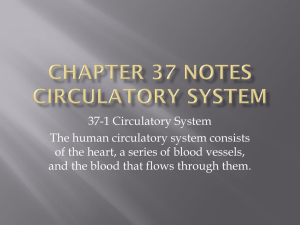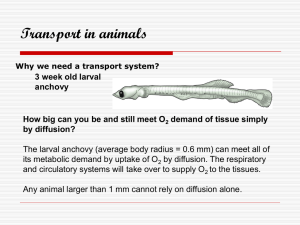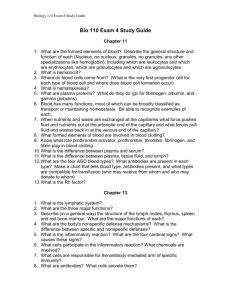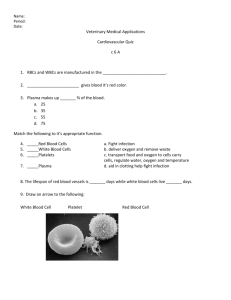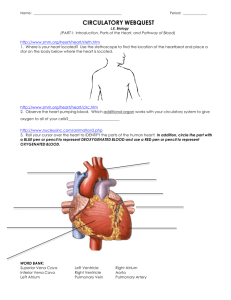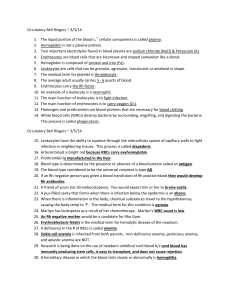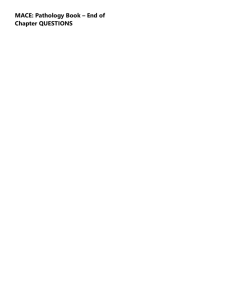Circulatory system (Dolphin, 2005).
advertisement
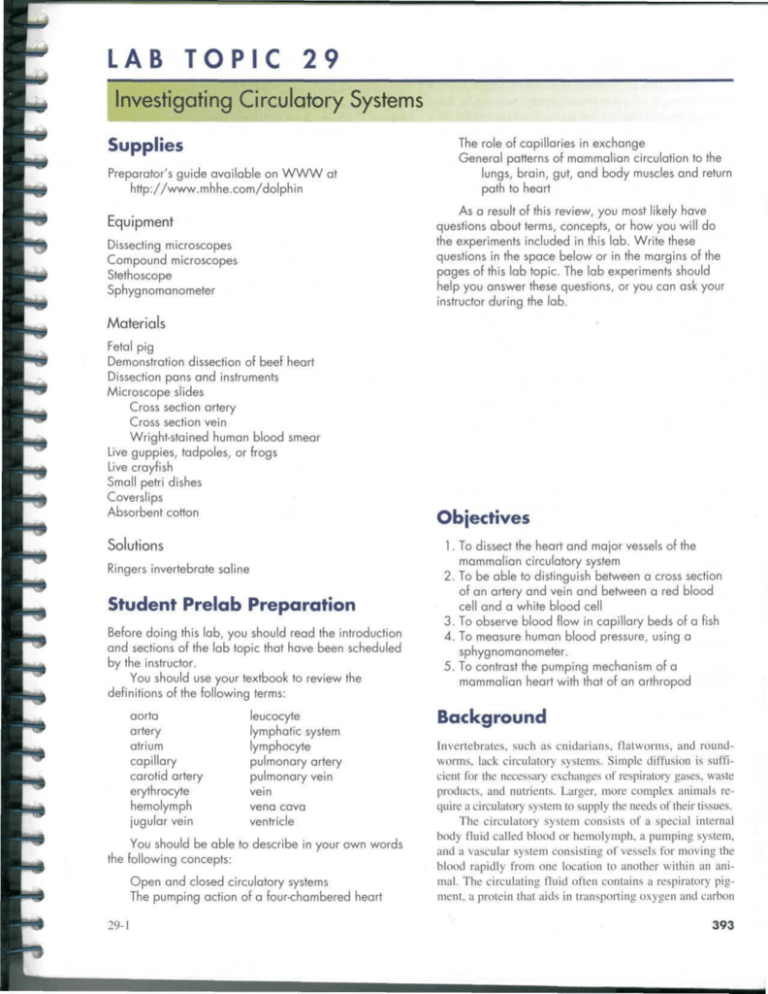
LAB T O P I C 29 Investigating Circulatory Systems Supplies Preparator's guide available on WWW at http://www.mhhe.com/dolphin The role of capillaries in exchange General patterns of mammalian circulation to the lungs, brain, gut, and body muscles and return path to heart As a result of this review, you most likely have questions about terms, concepts, or how you will do the experiments included in this lab. Write these questions in the space below or in the margins of the pages of this lab topic. The lab experiments should help you answer these questions, or you can ask your instructor during the lab. Equipment Dissecting microscopes Compound microscopes Stethoscope Sphygnomanometer Materials Fetal pig Demonstration dissection of beef heart Dissection pans and instruments Microscope slides Cross section artery Cross section vein Wright-stained human blood smear Live guppies, tadpoles, or frogs Live crayfish Small petri dishes Coverslips Absorbent cotton Solutions Ringers invertebrate saline Student Prelab Preparation Before doing this lab, you should read the introduction and sections of the lab topic that have been scheduled by the instructor. You should use your textbook to review the definitions of the following terms: aorta artery atrium capillary carotid artery erythrocyte hemolymph jugular vein -<* leucocyte lymphatic system lymphocyte pulmonary artery pulmonary vein vein vena cava ventricle You should be able to describe in your own words the following concepts: Open and closed circulatory systems The pumping action of a four-chambered heart 29-1 Objectives 1. To dissect the heart and major vessels of the mammalian circulatory system 2. To be able to distinguish between a cross section of an artery and vein and between a red blood cell and a white blood cell 3. To observe blood flow in capillary beds of a fish 4. To measure human blood pressure, using a Sphygnomanometer. 5. To contrast the pumping mechanism of a mammalian heart with that of an arthropod Background Invertebrates, such as cnidarians, flatworms, and roundworms, lack circulatory systems. Simple diffusion is sufficient for the necessary exchanges of respiratory gases, waste products, and nutrients. Larger, more complex animals require a circulatory system to supply the needs of their tissues. The circulatory system consists of a special internal body fluid called blood or hemolymph, a pumping system, and a vascular system consisting of vessels for moving the blood rapidly from one location to another within an animal. The circulating fluid often contains a respiratory pigment, a protein that aids in transporting oxygen and carbon 393 dioxide between the tissues and the respiratory surface. Hemocyanin and hemoglobin (which in vertebrates occurs in red blood cells) are common pigments. Blood also contains cells or proteins that protect against invasion by microorganisms and proteins that are involved in clotting, the sealing of leaks. The blood-vessel system often has anatomical provisions so that the blood is brought into close contact with three other physiological systems: lung or gill, where gas exchange occurs; excretory, where salt, water, and waste exchange occur; and digestive, where nutrients are absorbed. Circulatory systems may be either open or closed. In open circulatory systems, found in molluscs and arthropods, the arterial system is not connected to the venous system through capillary beds. Instead, the small arteries simply terminate, emptying their contents into the tissue spaces, and the blood (properly called hemolymph) directly bathes the tissues, eventually finding its way back to the heart. In closed circulatory systems, found in some invertebrates and all vertebrates, the flow of blood is always within blood vessels. The arterial system is connected to the venous system by means of capillaries which have very thin walls only one cell thick. Blood entering the capillaries is under relatively high pressure, and part of the fluid portion is filtered through the capillary walls, entering the tissue spaces. On the venous side of the capillary bed, most of this fluid flows back into the capillaries due to osmosis. Gaseous, waste, and nutrient exchanges between the blood and tissues occur by way of this fluid exchange as well as by diffusion. Blood flow in each capillary bed is regulated by the opening and closing of the precapillary sphincter, as seen in figure 29.1. The capillary bed, and only the capillary bed, is the functional site of the closed circulatory system where all exchanges take place. The lymphatic system consists of small open-ended lymphatic capillaries that conduct fluid into larger lymphatic ducts. Fluid that does not return to the blood capillaries enters the lymphatic capillaries. This fluid is collected in lymphatic ducts and returns to the venous system near the heart. Vertebrate circulation is summarized in figure 29.2. Consider the changes that occur in the blood as it passes through the various circuits. It is more important to understand the purpose of the circulatory system than to know a long list of names of vessels. You will observe the gross and microscopic features of the mammalian circulatory system and circulation in the capillary beds of a living vertebrate. You will learn how to measure the blood pressure of a human. Finally, you will observe a living arthropod heart in order to compare open and closed circulatory systems. Figure 29.1 Anatomy of a capillary bed. Fluid leaves the capillaries because of the pumping force of the heart, raising the osmotic pressure of the blood. Pumping pressure falls across the capillary bed due to drag and volume loss. On the venous side, fluids are drawn into the capillary by osmosis. Excess fluids enter the lymphatic capillaries. Metarteriole (forming arteriovenous shunt) Precapillary sphincter Arteriole Vein Blood flow Figure 29.2 Schematic of major mammalian blood vessels and their relationship to one another. Carotid artery Jugular vein Pulmonary artery Aortic arch Left atrium Dorsal aorta Left ventricle Right ventricle Right atrium Caudal vena cava Hepatic artery Hepatic vein Hepatic portal vein Coeliac plus mesenteric arteries Renal artery Extremities and other tissues 394 Investigating Circulatory Systems 29-2 Invertebrate Circulatory System Mammalian Circulatory System Most molluscs, arthropods, and many other invertebrates (but not all) have open circulatory systems. Of these, the crayfish's is most easily observed. See figure 22.7 for a diagram showing the crayfish's circulatory system. your fetal pig has not previously been opened, make a series of cuts as diagramed in the figure I.I, page 378. If you have followed the lab sequence in this manual, complete the opening as follows: 1. Make a longitudinal cut 1 cm to the left of the sternum Optional Demonstration of Open Circulation from the lower ribs to the region of the forelimbs and E^ To observe the heart of a crayfish, first anesthetize an animal parallel to the previous cut. Sever all ribs. by packing it in crushed ice in a glass finger bowl. Cover the 2. Lift up the center section, labeled (A) in figure 1.1 abdomen with wet cotton. The dorsal part of the carapace, (page 378), and cut any tissues adhering underneath. the exoskeleton covering the thorax, should be removed by A transverse cut at the anterior end will detach this inserting scissors under its posterior edge 1 cm to the left of center piece, which should be discarded. the midline and cutting forward to the region of the eye. This 3. The heart and lungs will be easier to observe if the procedure should be repeated on the right side, and the strip diaphragm is cut away from the rib cage on the of exoskeleton should be carefully lifted and removed, so animal's left side only. Cut close to the ribs. that none of the underlying membranes are torn. 4. In the region of the throat, remove the thymus glands, The heart can now be seen beating in the pericardial thyroid, and muscle bands, but do not cut or tear any sinus covered by the epidermal and pericardium membranes. major blood vessels. These membranes can be removed to expose the heart, which should be bathed in Ringer's solution to keep it from drying. In an open circulatory system such as this one, heThe Heart and Its Vessels molymph, the circulating fluid, leaves the heart in arteries 3)-Find the heart encased in the pericardial sac. Remove the but returns in open sinuses instead of veins. Under a dissac and identify the four heart chambers. The paired atria, secting microscope, you will be able to see the fluid surthin-walled, distensible sacs, collect blood as it returns to rounding the heart enter it through three pairs of slitlike the heart. The two ventricles are the large, muscular pumpopenings called ostia. These ostia open when the heart reing chambers of the heart. laxes and allow hemolymph to flow in. When the heart Blood returning from the systemic circulation enters contracts, flaps of tissue inside the heart close the ostia, and the right atrium from the cranial and caudal vena cavae. hemolymph is forced out of the heart through the arteries. After passing into the right ventricle, it is pumped to the You should be able to see the dorsal abdominal arlungs through the pulmonary trunk, which divides into tery, which carries hemolymph to the tail, and the ophthe left and right pulmonary arteries. The trunk is visible thalmic and antennary arteries, which carry hemolymph passing from the heart's lower right to upper left and passto the head region. Other arteries lie beneath the heart. ing between the two atria (fig. 29.3). In the mammalian Make a diagram of how the crayfish heart works. fetus, the pulmonary trunk and aorta are connected by a short, shunting vessel, the ductus arteriosus. Find this vessel in your animal. During the intrauterine life, when the lungs are not functional, most blood entering the pulmonary circuit does not pass to the lungs. Instead, it is shunted to the aorta. At birth, the shunting vessel constricts so that blood enters the lungs. The constricted vessel fills with connective tissue to become a solid cord seen in adults as the arterial ligament. Trace the pulmonary arteries to the lungs. Following gas exchange in the capillaries of the lungs, blood collects in the pulmonary veins and flows to the left atrium. These veins enter on the dorsal side of the heart and will be difficult to find. If you remove some of the lung tissue from the left side, you may be able to locate these vessels. From the left ventricle, blood is pumped at high pressure through the aorta to the systemic circulation. Find the aorta. It will be partially covered by the pulmonary trunk but can be identified as the major vessel that curves 180° to the pig's left, forming the aortic arch (fig. 29.3). m* 1—« 29-3 Investigating Circulatory Systems 395 Figure 29.3 External ventral and dorsal views of the fetal pig's heart. Left subclavian artery Brachiocephalic artery Cranial vena cava Aortic arch - Ductus arteriosus Brachiocephalic artery Right pulmonary artery Aorta Cranial vena cava Right pulmonary vein Right atrium Right ventricle Left pulmonary vein Caudal vena cava Coronary artery and vein Dorsal View Ventral View Vessels Cranial to the Heart Veins ecause the venous system is generally ventral to the arterial system, it will be studied first in the congested region of the heart. Refer to figure 29.4 and place a check next to each vein identified. Trace the cranial vena cava forward from the heart to where it is formed by the union of the two very short brachiocephalic veins. Each of these in turn is formed by the union of the five major veins: the internal and external jugular veins, which drain the head and neck; the cephalic vein, which lies beneath the skin anterior to the upper forelimb and typically enters at the base of the external jugular; the subscapular vein from the dorsal aspect of the shoulder; and the subclavian vein from the shoulder and forelimb. As the latter passes into the forelimb, it is known as the axillary vein in the armpit and the brachial vein in the upper forelimb. Caudal to the union of the brachiocephalic veins, is a pair of internal thoracic veins that drain the chest wall. These veins were most likely cut when you opened the animal. „ from the aorta is the brachiocephalic artery. It gives rise to the two carotid arteries, which pass anteriorly to supply the head, and the right subclavian artery, which passes to the right forelimb. Just to the left of the brachiocephalic artery, find the left subclavian artery arising as a separate branch from the aortic arch. Blood in this vessel goes to which region of the body? Once the aorta runs posteriorward along the dorsal wall of the thorax, it gives rise to intercostal arteries, which supply the walls of the chest. The aorta then passes through the diaphragm to become the abdominal aorta. Return to the left subclavian artery and trace it into the forelimb, removing skin and separating muscles as necessary. In the armpit it is known as the axillary artery, and in the upper forelimb as the brachial artery. Arteries The subscapular artery branches from the axillary artery the aortic arch and trace it back to the heart. Note the and supplies the shoulder muscles. The brachial artery diseveral arteries that branch off to supply the anterior region vides in the lower forelimb to give rise to the radial and of the animal. Refer to figures 29.4 and 29.5 to identify the ulnar arteries. vessels. Check off the arteries as they are identified. 6 Find another student in the lab who is at the same stage Find the small coronary arteries that arise from the in the dissection as you are. Quiz one another about the base of the aorta behind the pulmonary trunk. They supply path blood takes as it flows from the forelimb through the the muscles of the heart. The first major artery to branch heart to the head. 396 Investigating Circulatory Systems 29-4 Figure 29.4 Ventral view of the fetal pig's major arteries (a) and veins (v). Internal jugular v Common carotid a External jugular v Thyrocervical a Brachiocephalic v Cephalic v Axillary a Internal thoracic v Cranial vena cava Brachial a Radial a Dinar a Subscapular v Radial v Ulnar v Axillary v Right atrium Brachial v Subclavian v Aortic arch Ductus arteriosus Pulmonary trunk L. pulmonary a Hepatic v Caudal vena cava Diaphragm Coronary a Right ventricle Hepatic a Abdominal aorta Allantoic duct Umbilical a Renal a Kidney Renal v Caudal mesenteric a External iliac a Femoral v Femoral a External iliac a Internal iliac v Gonadal a Internal iliac a Median sacral a 29-5 Median sacral v Investigating Circulatory Systems 397 Figure 29.5 Major arteries in the region of the fetal pig's heart. Left common carotid artery Trachea Vagus nerve Esophagus Right subclavian artery Lung Left subclavian artery Brachiocephalic trunk Atria Aorta Pulmonary artery Ductus arteriosus Pulmonary trunk Ventricle Hemiazygous vein Dorsal aorta Lung Vessels Caudal to the Heart Veins £>If the heart is lifted and tilted forward, the caudal vena cava can be viewed at the point where it enters the right atrium. As this vein is traced caudally, several veins will be found flowing into it. After it passes through the diaphragm, the paired hepatic veins and single umbilical vein enter first. The umbilical vein carries oxygenated, nutrient-laden blood from the placenta. This vein passes through the liver where it is known as the ductus venosus. The hepatic portal vein runs next to the common bile duct under the lobes of the liver. It will be difficult to find. Nutrient-laden blood flows through this vein to the liver 398 Investigating Circulatory Systems where exchanges occur between the blood and the liver across the walls of the portal system capillaries. The blood then flows into the hepatic veins, which enter the caudal vena cava. Follow the vena cava caudally to where the renal veins enter from the kidneys. In the male, the spermatic veins, and in the female, the ovarian veins, enter next. On the left side, these veins may enter the renal vein first. Below the kidneys, the vena cava splits into the internal and external iliac veins and the median sacral vein, a small vein that comes from the tail. The external iliac veins collect blood from the femoral veins in the hind legs, whereas the internal iliacs collect blood from the pelvic area. 29-6 Figure 29.6 Lateral view of circulatory system in fetal pig (arteries—red, veins—blue). Label the major arteries and veins. Heart Aorta Lu n ,9 Caudal vena cava Liver Kidney Small intestine Hepatic portal system Large intestine Arteries £> After the aorta enters the abdominal cavity, a large, single coeliac artery arises from it at the cranial end of the kidneys. You will have to remove some connective tissues to obtain a full view of this artery. The coeliac artery eventually divides into three arteries supplying the stomach, spleen, and liver. The mesenteric artery next arises from the aorta and supplies the pancreas, small intestine, and large intestine. The renal arteries are short, paired arteries supplying the kidneys. The next large arteries arising from the aorta are the external iliacs, which supply the hind legs with a branch to the lower back. In the fetus, the umbilical arteries branch from the caudal end of the abdominal aorta and pass out through the umbilical cord. They form a capillary bed in the placenta for nutrient, gas, and waste exchange with the maternal circulatory system. Find another student in the lab who is at the same stage in the dissection as you are. Quiz one another about the circulation paths to the major organs and hind limbs. Look at the diagram in figure 29.6 and add labels to the major arteries and veins that you identified in your dissection. Internal Heart Structure 1J^ Study the orientation of the heart so that you can later identify it in isolation. Now, free the heart from the body by cutting through all the vessels holding it in place. Be careful to 29-7 leave enough of each vessel so that they can be identified in the isolated heart. Alternative to removing the fetal pig's heart, your instructor may have a demonstration dissection of a beef heart or heart models for you to study. Whichever specimen you are using, orient yourself by identifying the aorta, pulmonary artery, pulmonary vein, and vena cava. Place the heart in your dissecting pan, ventral side up. Make a razor cut along the pulmonary trunk down through the right ventricle. Spread the tissue open, pin it down, and remove the latex. You may wish to use a dissecting microscope to observe the open ventricle. Identify the semilunar valves at the junction of the artery and ventricle. Consider how these valves work. The open flaps face into the pulmonary trunk, and any backflow in the pulmonary trunk fills the valve flaps with blood and closes the valve. You may have to cover the heart with water to float the valve flaps so that you can see them (fig. 29.7). Now cut through the right atrium and remove the latex and coagulated blood. The tricuspid valves are between the atrium and ventricle. These valves also work on the backflow principle, allowing blood to flow only one way from the atrium into the ventricle. In the ventricle, fine fibers called chordae tendinae are attached to the valve flaps. These cords prevent the flaps from "blowing back" from high pressures developed when the ventricle contracts. Cut into the left atrium and ventricle as you did on the right side. Identify the bicuspid or mitral valve between Investigating Circulatory Systems 399 Figure 29.7 from above. Human heart: (a) the path of blood flow through the major chambers and vessels; (Jb) valves of the heart viewed Aorta Cranial vena cava Left pulmonary artery Pulmonary trunk Right pulmonary veins Left pulmonary veins »•"*• Left atrium Pulmonary semilunar valve Aortic semilunar valve Right atrium Bicuspid valve Tricuspid valve Chordae tendineae Papillary muscle Left ventricle Right ventricle Caudal vena cava (a) Pulmonary semilunar Aortic semilunar valve Opening of coronary artery Bicuspid valve (b) 400 Investigating Circulatory Systems Jricuspid valve Figure 29.8 Histology of arteries and veins: (o) tissues in the wall of an artery; (b) tissues in the wall of a vein; valves in veins prevent backflow of blood in the venous sytem. Artery Vein Endothelial lining Valve Connective tissue Elastic tissue Muscle layers the atrium and ventricle with its associated chordae tendinae. After cutting into the ventricle and cleaning it, find the aortic semilunar valve. Blood flow through the human heart is shown in figure 29.7. Pair off with another student and describe how blood returning to the heart from the foreleg travels to the lungs and then to the hindleg. Describe the operation of the heart valves. Clean your dissecting instruments and tray and return your fetal pig to the storage area. Histology of Vessels tain prepared slides of cross sections of arteries and veins and observe them under low power with a compound microscope. Note that arteries have thicker walls than veins of the same size. Most of the difference in thickness is due to the increased amounts of muscle and connective tissue in the artery. Since arteries carry blood from the heart, they operate under relatively high pressure (average 120 mm of mercury equivalent). Veins experience only one-twentieth as much pressure. Blood flows through veins because skeletal muscles press on them and move the blood along. Valves in the veins prevent backflow and make the passage of blood unidirectional (fig. 29.8). Observe the tissues of a blood vessel under lOx. Endothelial cells are epithelial cells that line both arteries and veins; capillary walls consist of only endothelial cells. When the muscle layers are contracted in the smallest arter29-9 Figure 29.9 Scanning electron micrograph of a broken blood vessel, showing the smooth endothelial lining and several red blood cells (RBC). BB RBC Vessel wall ies, the total volume of the vascular system is reduced and the blood pressure rises. Figure 29.9 shows the nature of the endothelial lining of blood vessels and red blood cells in an arteriole. The complexity of the microvasculature is evident in scanning electron micrographs of casts of the circulatory system. Note the capillaries and their relationship to arterioles in figure 29.10. Investigating Circulatory Systems 401 Figure 29.10 Scanning electron micrograph of a plastic cast of a capillary bed from skeletal muscle in which individual arterioles can be traced to capillaries. From R. G. Kessel and R. H. Kardon. Tissues and Organs: A Text-Atlas of Scanning Electron Microscopy. 1 979. W. H. Freeman and Company. Figure 29.11 Human blood stained with Wright's stain shows red blood cells and different types of white blood cells; (a) neutrophil; (b) lymphocyte. Arteriole Capillary Blood Human blood consists of 55% plasma and 45% cells by volume. Plasma is the fluid portion of the blood containing dissolved proteins, salts, nutrients, and waste products. Several different types of cells and cell fragments are contained in blood. By far the most common (about 95% of the cells) are erythrocytes (red blood cells) which are red because they contain hemoglobin. The other 5% are collectively called leukocytes (white blood cells) and platelets that are important in blood clotting. There are several types of leukocytes. The most common, neutrophils and lymphocytes, representing 95% of the white blood cells, are shown in figure 29.11. The remaining types of cells, basophils and monocytes, represent only 5% of the white blood cells. Get a prepared slide of a Wright-stained human blood smear from the supply area and look at it with your compound microscope under medium power. Note the large A number of red blood cells. Can you see a nucleus in these cells?_ . Why do you think that the red blood cells are lighter in color in the center and darker at the periphery? 402 Investigating Circulatory Systems As you look carefully at the slide, you will see occasional cells that look different. These are leukocytes and because of the staining they have a blue/purple color. Center a leukocyte in the field of view and observe it with high power. What structure in the cell is stained? . Return to medium power and scan the slide to locate other leukocytes. Try to find examples of each of the types shown in figure 29.11. Neutrophils leave the blood early in the inflammation process and become phagocytic cells consuming cell debris and bacteria. Lymphocytes are important in the immune response. Some are involved in cellular immunity and others secrete antibodies that neutralize foreign proteins and other macromolecules. Return your slide to the supply area. 29-10 L IF Figure 29.12 Method for observing microcirculation in a fish tail. t Mi (1) Wrap the fish (except for the head and tail) with dripping wet cotton. Place fish in half of a petri dish. Place coverslip over tail. Place the dish on a compound microscope stage and observe the tail under scanning power. Sketch your observations, answering the following questions: 1. Can you identify capillaries, venules, and arterioles? 2. Is blood flow faster in certain vessels compared to others? (2) Place dish on microscope so that fish's tail is over hote in stage. 3. Is blood flow continuous in all vessels? What might control this? Dilute solutions of nicotine, caffeine, and adrenalin are available in the lab in dropper bottles. Devise an experiment to determine the effects of these chemicals on capillary circulation. (3) Examine with low- and medium-power objectives of your microscope. Circulation in Capillaries o observe circulation in capillaries, net a small fish or tadpole from an aquarium and wrap it in dripping wet cotton, as shown in figure 29.12, being careful not to cover the head or the tail. Lay the wrapped fish in an open petri dish. About every five minutes return the fish to water. Place a few drops of water on the tail and add a coverslip over the tail. 29-11 Measuring Blood Pressure Blood pressure is the pressure that the blood exerts on the walls of blood vessels and is usually measured in arteries. Because of the contraction cycle of the heart, pressure varies from a high (systolic) to a low (diastolic) pressure during a cycle. Pressures are reported in mm of mercury (Hg) with the systolic pressure appearing first. Thus a blood pressure reading of 120/60 means that the pressure just following maximum contraction is 120 and just following maximum relaxation is 60 mm of Hg. In this section, you will learn how to take a blood pressure reading by the indirect method. Method An instrument called a sphygmomanometer and a stethoscope are used in this method. An inflatable cuff is placed around a person's arm (fig. 29.13) and inflated until the pressure exerted is greater than the systolic Investigating Circulatory Systems 403 Figure 29.13 Method to be used in measuring blood pressure. column of mercury indicating pressure in mm Hg No sounds 1 (artery is closed) •<- systole = <- diastole = 0 • Sounds heard (artery is opening and closing) o No sounds (artery is open) = inflatable rubber cuff brachial artery sounds are heard with stethoscope I air valve S -squeezable bulb inflates cuff with air pressure, thus collapsing the arteries in the upper arm. The pressure in the cuff is gradually reduced while the operator listens for resumption of blood flow in the arteries with a stethoscope (fig. 29.13). The pressure at which faint tapping sounds are heard is taken as the systolic pressure. As pressure in the cuff is further reduced, louder sounds are heard because of turbulent blood flow through the partially compressed artery. There is a pressure at which these sounds stop when blood flow becomes laminar. This pressure is considered the diastolic pressure. 16 Work with a partner to measure these pressures. The subject should sit with the arm extended and resting on a table. Your instructor may explain in more detail how to do the following procedures. Results Record your results below: First trial Systollic pressure Diastolic pressure Second trial Systolic pressure Diastolic pressure What range of pressure values were observed in the class? Were there any differences between genders? Were there any differences between athletes and non-athletes? 1. Wrap the cuff around the upper arm in such a way that the inflatable area is over the inner surface of the arm where the brachial artery is located. 2. Don the stethoscope and place the end over the pulse point located on the inside of the elbow joint (fig. 29.13). 3. Inflate the cuff to about 160 mm of pressure. DO NOT OVER INFLATE! 4. Slowly release the pressure by opening the valve on the squeeze bulb as you listen for the first thudding sounds of blood flow. Note the pressure when you hear them. Continue to reduce pressure until the sounds are no longer heard. Note the pressure reading when this happens. 404 Investigating Circulatory Systems 29-12 T2^Blood Pressures under Experimental Conditions Assuming that you now can measure blood pressures rather quickly, try doing so under these experimental conditions: Have a fully cuffed subject recline on a table for two or three minutes and then quickly stand as you inflate the cuff. Take your measurements and record below: Does this measurement have any relationship to lightheadedness that is sometimes felt when getting up quickly? Explain? First trial Systolic pressure Diastolic pressure Second trial Systolic pressure Diastolic pressure Learning Biology by Writing Your instructor may ask you to answer the Lab Summary and Critical Thinking questions that follow. Internet Sources Many medical schools have extensive collections of pictures of pathological conditions. These collections are available over the WWW. Use your browser program and a search engine to locate pictures of a blood vessel with arteriosclerosis. Compare this picture to your observations of a normal artery in the lab. Describe the differences. Lab Summary Questions —* E 1. Create a flowchart showing the major vessels and heart chambers that a drop of blood passes through as it returns from the arm and passes to the back leg. 2. Create a flowchart showing the major vessels and heart chambers that a drop of blood passes through as it returns from the small intestine and passes to the brain. 3. List the valves of the heart and describe how they operate. 29-13 4. What are the structural differences between an artery and a vein? How do capillaries differ? 5. How does the open circulatory system of a crayfish differ from the closed system of a mammal? Describe how blood returns to and enters the heart of both types of animals. 6. Trace a molecule of oxygen from when it enters the pig's nostril to when it enters the tissues of the upper hind leg. Then trace a carbon dioxide molecule as it passes from the leg back to the nostril. 7. Explain what blood pressure is and what it means when a person says their blood pressure is 125/70. Critical Thinking Questions 1. What are the roles of the lymphatic system and the venous system in returning fluid filtered through the microcirculation? 2. Since a giraffe's head is 15 feet above the ground, what circulation adaptations are necessary to allow adequate blood supply to the head? 3. If arthropods such as insects have open circulatory systems that lack veins, how does hemolymph return from the tissues to the heart? 4. Based on your lab observations, give an opinion on the following situation: A person has a blood pressure of 150/90. Investigating Circulatory Systems 405
